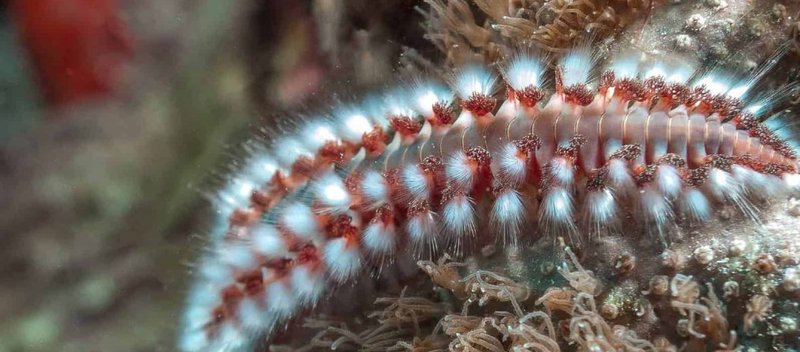
Bristle worms belong to the polychaete group of annelids and come in many varieties, each with unique reproductive strategies. Understanding their reproductive cycle can give us insight into how they thrive in their environments. So grab a cup of coffee and let’s dive into the fascinating world of bristle worm reproduction!
What Are Bristle Worms?
Before we dig into their reproductive cycle, let’s establish what bristle worms actually are. These creatures are segmented worms that can be found in both marine and brackish waters. They have bristles, or chaetae, made of chitin protruding from their sides, which is where they get their name. These bristles help them move through the water or burrow into the sand.
Bristle worms come in many shapes and colors, which can be quite stunning to see. Some are tiny, only a few millimeters long, while others can grow over a meter! They live in various habitats, including coral reefs, mudflats, and even deep-sea environments. So, they’re essentially the unsung heroes of the ocean floor, helping decompose organic matter and serving as food for various marine animals.
How Do Bristle Worms Reproduce?
Bristle worms have a fascinating reproductive cycle that varies among species. Most bristle worms can reproduce both sexually and asexually. When it comes to sexual reproduction, males and females often participate in a process that involves external fertilization. The males and females will typically release their gametes (sperm and eggs) into the water, where fertilization occurs.
Here’s the thing: the timing of this event depends on environmental factors like temperature and lunar cycles. It’s almost like a seasonal festival! When the conditions are just right, males and females will swim to the surface, where they perform a synchronized release of their reproductive cells, ensuring a higher chance of fertilization. This synchronized event is crucial because it maximizes the number of eggs that get fertilized, allowing more offspring to survive.
Life Cycle of a Bristle Worm
Let’s break down the bristle worm life cycle into stages. After fertilization, the eggs develop into free-swimming larvae known as trochophore larvae. These larvae are tiny and have distinctive bands of cilia (tiny hair-like structures) that help them swim. They float around in the water column, feeding on microscopic food particles.
As they grow, these larvae undergo a transformation into a more mature form called a juvenile worm. This transformation is pretty remarkable; it’s like watching a caterpillar turn into a butterfly! Once they reach a certain size, they settle on the ocean floor and begin their lives as adult worms, ready to continue the cycle.
Asexual Reproduction: Fragmentation
Not all bristle worms rely on sexual reproduction. Many species can reproduce asexually through a process called fragmentation. In simple terms, if a bristle worm gets cut into pieces, each piece can regenerate into a complete worm. This ability allows them to reproduce under stressful conditions where finding a mate may be difficult.
Imagine breaking a LEGO model into smaller pieces, with each piece capable of rebuilding itself into a full model. This strategy is beneficial for bristle worms, especially in environments where their populations may be sparse or unstable. It’s a smart survival tactic that ensures their numbers can bounce back even after significant losses.
The Role of Temperature and Environment
The reproductive cycle of bristle worms doesn’t happen in a vacuum. It’s deeply influenced by environmental factors. For instance, water temperature plays a critical role in determining when bristle worms will spawn. Typically, warmer temperatures signal the right time for reproduction, as food sources are abundant, and conditions are favorable for larvae survival.
Additionally, other environmental cues, like salinity and availability of food, can impact their reproductive success. This means that they are continually adapting to their changing environments, ensuring that their life cycle can continue even in fluctuating conditions.
Importance of Bristle Worm Reproduction in Ecosystems
Understanding how bristle worms reproduce is not just a biology lesson—it’s a window into the health of marine ecosystems. As they contribute to nutrient cycling and provide food for other marine species, their reproductive success impacts the entire food web. When they thrive, the ecosystem benefits, showing just how interconnected life in our oceans can be.
Moreover, bristle worms help break down organic materials, making nutrients available for other organisms. This role is particularly important in habitats like coral reefs, where nutrient cycling is crucial for the overall health of the reef system. The more healthy reproducing bristle worms there are, the healthier the ocean ecosystem tends to be.
The bristle worm reproductive cycle is an incredible example of nature’s complexity and resilience. From synchronized spawning to the remarkable ability to regenerate, these creatures show us how life can adapt and thrive in various conditions. As we learn more about their reproductive strategies, we gain a deeper appreciation for the delicate balance of marine ecosystems.
So next time you think about the ocean, remember the bristle worms and their vital role in maintaining the health of our underwater world. It’s a reminder that every tiny creature, no matter how seemingly insignificant, has a part to play in the circle of life. Who knew that such slimy worms could have such a profound impact? Let’s continue to explore and learn about the wonders of our oceans together!
